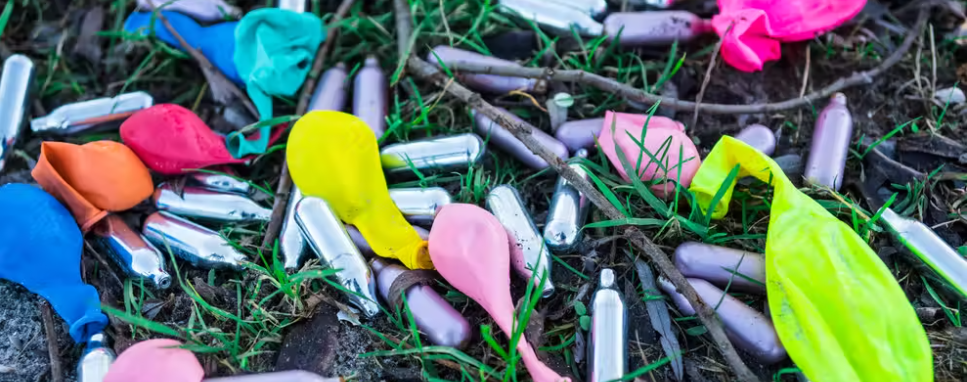EMCDDA review of nitrous oxide in Europe
In November 2022, the EMCDDA launched a new report ‘Recreational use of nitrous oxide – a growing concern for Europe’ which examines the trend of recreational nitrous oxide use across Europe.
The report examines the latest situation in terms of prevalence, the know health and social harms as well as different countries responses. To support this, the report also provides a state-of-the-art review of the chemistry, pharmacology and toxicology of the gas. In addition, it includes detailed country case studies from Denmark, France, Ireland, Lithuania, the Netherlands and Portugal. A case study is also provided on the United Kingdom, where the use of nitrous oxide has been established in young people for a longer period.
Summary: Irish case study on nitrous oxide
At present, nitrous oxide is not a controlled substance under the Misuse of Drugs Act 1977. It can be legally sold for catering and industrial purposes. The Criminal Justice
(Psychoactive Substances) Act 2010 prohibits the sale, importation or exportation of psychoactive substances; under this legislation, it is illegal to sell nitrous oxide for its psychoactive properties.
Epidemiology
Nitrous oxide use among adults
- Prevalence of nitrous oxide use is not routinely collected in Ireland’s National Drug and Alcohol survey. The only source of data on adult nitrous oxide use is the 2021 European Web Survey on Drugs (EWSD), in which Ireland participated and which included a module on nitrous oxide. Only adults aged 18 and over and who had used drugs were included in this survey. Data were collected from March-May 2021.
- Of the 4 398 respondents who answered this question, 1.1 % reported last month use and a further 3.7 % had used nitrous oxide in the last year. In total, 23.3 % had ever used nitrous oxide.
- Respondents aged 18-24 years were most likely to have used nitrous oxide in the last year.
- The module on nitrous oxide was completed by 142 respondents; 39 % of respondents stated that they had first used nitrous oxide in the last year and 32 % had first used it 1-2 years ago.
Nitrous oxide use among young people
The only available data on nitrous oxide use among young people (<18 years) is a Planet Youth survey conducted among post-junior certificate students in schools in North
County Dublin in 2021. The questions on nitrous oxide were answered by 2 384 respondents. The main results were:
- 6.2 % of young males and 5.3 % of young women have ever used nitrous oxide;
- there was a gender x grade interaction, with males attending fifth year in the sample having significantly greater lifetime prevalence of use at 11.9 %;
Nitrous oxide use in festival settings
- A 2019 online survey of 1 193 Irish festival attendees aged 18 and over found that 28 % had used nitrous oxide while attending music festivals in Ireland in the last year.
- Ofthose who had attended music festivals abroad (n = 619), 38 % had used nitrous oxide. Respondents to this survey typically used stimulant ‘club drugs’ mainly as part of a polydrug use pattern (Ivers et al., 2022).
Seizures of nitrous oxide
A request was submitted to An Garda Síochána regarding seizures of nitrous oxide. They replied that there have been a number of significant seizures of canisters containing nitrous oxide in Ireland over the past couple of years. However, information on the number and size of the seizures is not published as there are still issues in relation to the forensic analysis of nitrous oxide, which they are currently in the process of advancing.
Harms associated with nitrous oxide
Requests for information were submitted to a number of sources in order to assess the extent of nitrous oxiderelated harm in Ireland: the National Drug Treatment
Reporting System (NDTRS), the National Drug Related Deaths Index (NDRDI), the Hospital Inpatient Enquiry (HIPE) scheme and emergency departments.
National Drug Treatment Reporting System (NDTRS):
- In mid-2020, in response to anecdotal reports of increased use, the NDTRS added nitrous oxide to its system. In 2020, fewer than five episodes of treatment were reported. Preliminary data from 2021 indicate that 10 episodes of treatment were reported. The majority of these cases were male and the mean age was 16 years. All were new cases, i.e. they had never received treatment before, and most were polydrug users who also reported cannabis use.
National Drug Related Deaths Index (NDRDI):
- The NDRDI recorded no drug poisoning deaths due to nitrous oxide for the period 2004-2017 inclusive. Data for 2018 onwards are not yet available.
Hospital Inpatient Enquiry (HIPE) scheme: HIPE records information on discharges from hospitals in Ireland:
- Poisoning by nitrous oxide falls under the ICD-10-AM code T41.0 ‘Poisoning by Inhaled anaesthetics’; as this code is used for poisoning by any inhaled anaesthetic, it is not specific to nitrous oxide. However, analysis of discharges from 2018-2020 inclusive indicate that, in this 3-year period, there were fewer than five discharges with a T41.0 diagnosis.
Emergency departments:
- A case report was published in 2022 describing the presentation of two young males to the emergency department of a large urban university hospital in Dublin with progressive neurological dysfunction related to nitrous oxide use (McCormick et al., 2022). A case with subacute combined degeneration of the spinal cord secondary to nitrous oxide use has also been reported by a hospital in Dublin














